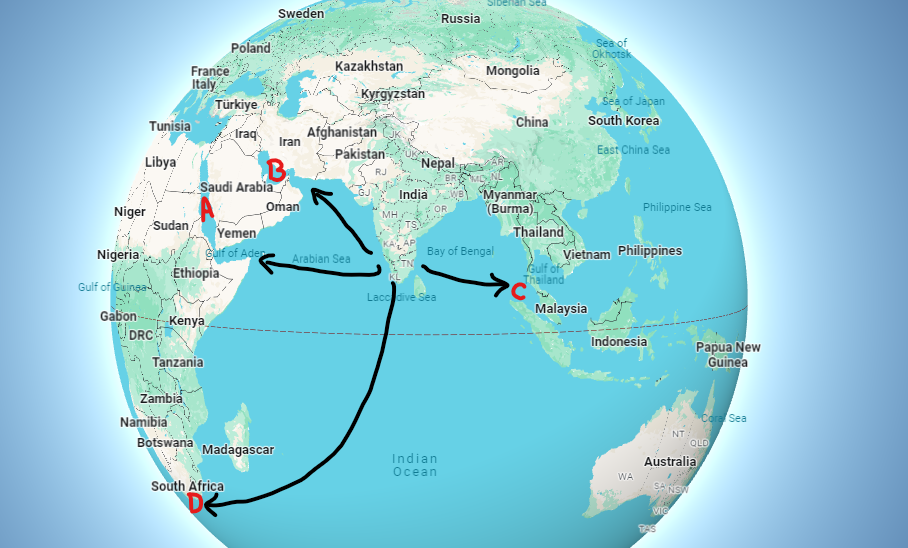In recent weeks, the Red Sea has become a hotspot of geopolitical tension as Houthi rebels (Iran backed Rebel group against Israel) in Yemen intensify attacks on commercial vessels transiting the Bab-el-Mandeb strait. This strategic waterway connects the Arabian Peninsula to the Horn of Africa, a vital passage for global trade between Asia and Europe via the Suez Canal and the Mediterranean.
Key Points:
1. Red Sea Trade Disruption:
- Houthi rebel attacks have forced shipping giants (Maersk, Hapag-Lloyd, BP) to suspend Red Sea cargo movements.
- US navy deployed helicopters defended a Maersk vessel and shot down 24 Houthi drones, highlighting the conflict’s escalation.
2. Global Trade Impact:
- Red Sea (between Sudan and Yemen shown by A in the map below) handles 12% of global trade and 30% of container traffic.
- Rerouting around the Cape of Good Hope, D, adds 3,000-3,500 nautical miles, prolonging journeys by 10 days, impacting shipping and increasing costs.

3. Economic Ramifications:
- Rerouting may cost up to $1 million extra in fuel per round trip, leading to rising shipping and insurance costs.
- Tankers and container shipments face delays, affecting the transportation of diesel, jet fuel, and consumer goods.
4. Potential Inflation Impact:
- Increased shipping times and costs, coupled with pre-existing pandemic-related spikes, may contribute to inflation.
- Despite recent spikes, current freight costs are lower than two years ago; limited impact on inflation if the disruption is brief.
5. Context Matters:
- Unlike the 2021 Suez Canal incident, the global economic landscape has changed with slowing inflation.
- Recent freight cost spikes, though present, are lower than two years ago; the disruption’s impact on inflation may be restricted if it’s short-lived.
Impact on India:
Most of our Petroleum imports have been insulated as they take the routes through the Strait of Hormuz and Strait of Malacca shown by B and C shown in the map above. However, exports of rice and textile through the Red Sea (shown by A) have been affected.
Recent attacks on Indian-affiliated vessels (MV Chem Pluto and MV Sai Baba) have raised concerns for India, focusing on two critical aspects:
- Oil Imports:
- Despite vessel attacks, Russian imports doubled to 1.76 million bpd, providing a crucial buffer.
- Russia now leads as the top supplier, with decreased contributions from Iraq and Saudi Arabia.
- Shipping Costs:
- Visible impact on rice exports and a nearly 70% surge in freight rates from Mundra to the US pose a potential $30 billion export drop.
- About 50% of Indian imports and 60% of exports may have used this route according to GTRI report.
- Heightened shipping risks in the Red Sea prompted a 25% holdback in outbound shipments, affecting various goods.
Stock Market Implications:
- Brent has consistently stayed below $80, a positive for India in terms of Oil import bill amidst the crisis.
- This further means that, among the two challenges, rise in shipping costs could pose a higher risk, which could create an inflationary environment and delay expected interest rate cuts.
- Major Indian shipping companies and sectors like energy and commodities may face heightened volatility.
- Indian exporters in industries such as textiles and apparels have started to feel the heat with extended delays. However, the government has told ECGC not to raise insurance rates for now to comfort exporters.
Conclusion: As the Red Sea turmoil continues, the world watches closely to gauge the extent of its impact on global trade and potential inflation shocks. The same applies to India, although India is known to effectively maintain a fine balance with nations when it comes to its own strategic interests.
